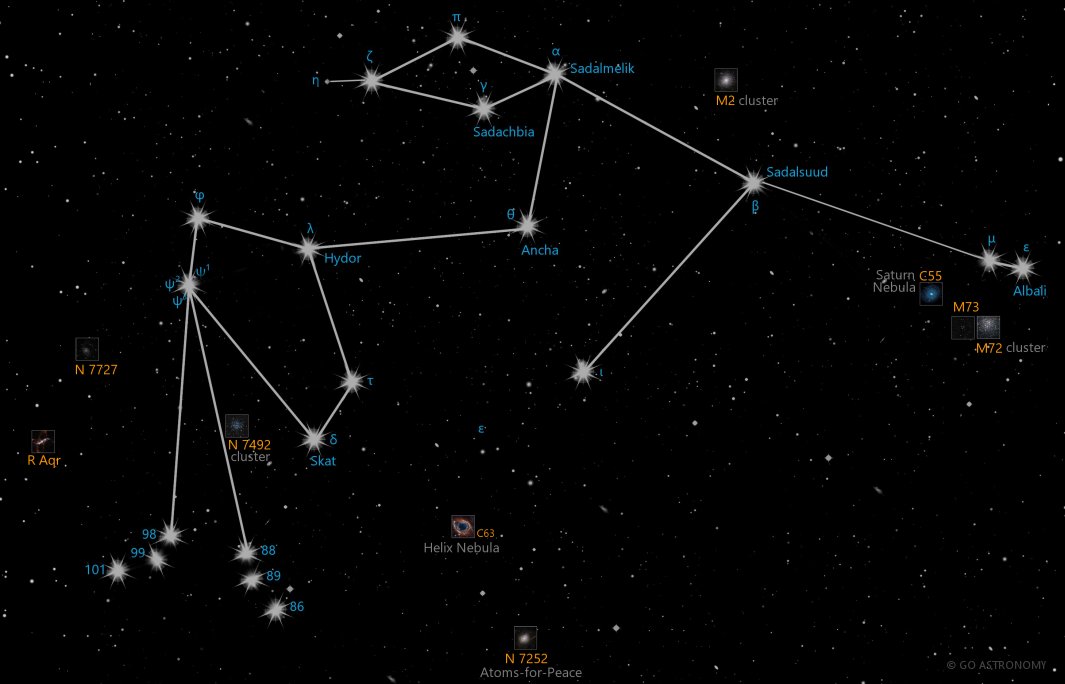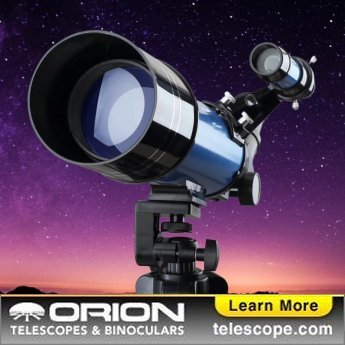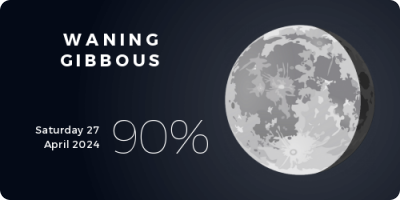Aquarius, the Water Bearer (Aqr)
(uh-QUAIR-ee-us)
The Southern constellation of Aquarius, the Water Bearer, is best viewed in Fall during the month of October.
Aquarius is the 10th largest constellation. It's brightest star is Sadalsuud at magnitude 2.90. The boundary of the Aquarius constellation contains 17 stars that host known exoplanets.
Aquarius is an equatorial constellation, which means its bulk intersects the celestial equator or comes within 10-15 degrees of doing so. Aquarius is visible from most places on Earth.
- Pronunciation:
- uh-QUAIR-ee-us
- Meaning:
- Water Bearer
- Genitive:
- Aquarii
- Abbreviation:
- Aqr
- Asterism:
- Water Jar
- Constellation Family:
- Zodiacal
- Hemisphere:
- Southern
- Quadrant:
- SQ4
- Visibility:
- 65° N - 90° S
- Best viewing month*:
- October
- Area:
- 980 sq. degrees
- Size:
- 10th largest
- Equatorial:
- Yes
- Right Ascension (avg):
- 22h 42m
- Declination (avg):
- -10°
- Brightest star:
- Sadalsuud (2.90)
- Stars with planets:
- 17
Brightest Stars in Aquarius
The 10 brightest stars in the constellation Aquarius by magnitude.
- Star
- Magnitude
- Spectral class
- Beta Aquarii (β Aqr)
- 2.9
- G0Ib
- Alpha Aquarii (α Aqr)
- 2.95
- G2Ib
- Delta Aquarii (δ Aqr)
- 3.27
- A3V
- Zeta Aquarii (ζ1 Aqr)
- 3.65
- F3III-IV
- 88 Aquarii (88 Aqr)
- 3.68
- K1III
- Lambda Aquarii (λ Aqr)
- 3.73
- M2IIIvar
- Epsilon Aquarii (ε Aqr)
- 3.78
- A1V
- Gamma Aquarii (γ Aqr)
- 3.86
- A0V
- 98 Aquarii (98 Aqr)
- 3.96
- K0III
- Eta Aquarii (η Aqr)
- 4.04
- B9IV-Vn
Double Stars in Aquarius
These are the brightest and easiest-to-find double, triple, and quadruple star systems in the constellation Aquarius. Also see all star clusters.
- Star system
- Magnitudes
- Type
- Zeta Aquarii
- 4.3, 4.5
- double
- 94 Aquarii
- 5.3, 7.0
- double
Star Clusters in Aquarius
The most notable and easy-to-find star clusters in the constellation Aquarius . Also see all star clusters.
Nebulae in Aquarius
Notable and easy-to-find nebulae in the constellation Aquarius . Also see all nebulae.
Galaxies in Aquarius
The most notable galaxies in the constellation Aquarius. Also see all galaxies.
Milky Way Satellites in Aquarius
Dwarf satellite galaxies that orbit the Milky Way Galaxy located in the constellation Aquarius. Also see all Milky Way satellite galaxies.
- Galaxy name
- Alt name
- Magnitude
- Aquarius II
The Celestial Water Bearer
Aquarius, often recognized as the 'Water Bearer,' is one of the oldest recognized constellations in the sky. This ancient constellation belongs to the Zodiac family and has been part of human folklore for thousands of years. With its wealth of fascinating deep sky objects and a rich history rooted in mythological and astronomical tradition, Aquarius offers plenty to explore.
History and Mythology
Aquarius has been recognized by many cultures across history, but it is most commonly associated with the ancient Greeks. In Greek mythology, Aquarius represents Ganymede, the cupbearer of the gods. Zeus, the king of the gods, was said to have been so taken by Ganymede's beauty that he transformed into an eagle and brought Ganymede to Olympus to serve as a cupbearer, hence the 'Water Bearer'.
However, the constellation was recognized long before the Greeks. The ancient Babylonians identified Aquarius as an important symbol in their beliefs, where it represented their god Ea, who is often depicted holding an overflowing vase.
Location and Features
Aquarius is located in the fourth quadrant of the Southern Hemisphere but can be seen at latitudes between +65? and -90?. This makes Aquarius visible to observers in both the Northern and Southern Hemispheres. It is bordered by several constellations including Capricornus, Piscis Austrinus, Sculptor, Cetus, Pisces, and Equuleus.
The constellation of Aquarius is not particularly bright, with only two stars above the third magnitude. Sadalsuud, or Beta Aquarii, is the brightest star in Aquarius with an apparent magnitude of 2.91. It is a yellow supergiant star around 6.4 times larger than our Sun and located approximately 610 light-years away. Sadalmelik, or Alpha Aquarii, is another notable star in the constellation and is an evolved G-type supergiant located roughly 520 light-years away.
Deep Sky Objects
Aquarius is home to a variety of deep sky objects, ranging from nebulae to galaxies. One of the most notable objects is the Saturn Nebula (NGC 7009), a planetary nebula so named because it appears similar to the planet Saturn through small telescopes. Another popular target is the Atoms for Peace Galaxy (NGC 7252), which is the result of a collision between two galaxies.
The constellation also contains several globular clusters, including M2 and M72. M2 is one of the largest known clusters, containing about 150,000 stars, and can be seen with a small telescope. It is approximately 37,500 light-years away from Earth and has an apparent magnitude of 6.5.
Observing Aquarius
Given its celestial location, Aquarius is best observed during the fall months, particularly in September, when it reaches its highest point in the night sky. While its stars are not particularly bright, the constellation is still quite large and recognizable, especially from darker viewing locations.
For stargazers and astronomers alike, the constellation Aquarius offers a host of fascinating celestial objects. Its ancient lineage, mythological ties, and rich array of deep sky objects make it a captivating part of our night sky.
* Constellation shown for northen hemisphere skies. For the southern hemisphere, constellations appear rotated 180 degrees (upside-down and left-right reversed) from what is shown. Remember that seasons are reversed too - summer in northern latitudes is winter in southern latitudes.
** Circumpolar constellations are visible year-round in the hemisphere listed (and not at all in the opposite hemisphere).





